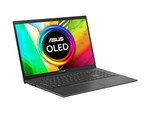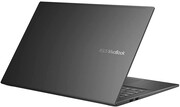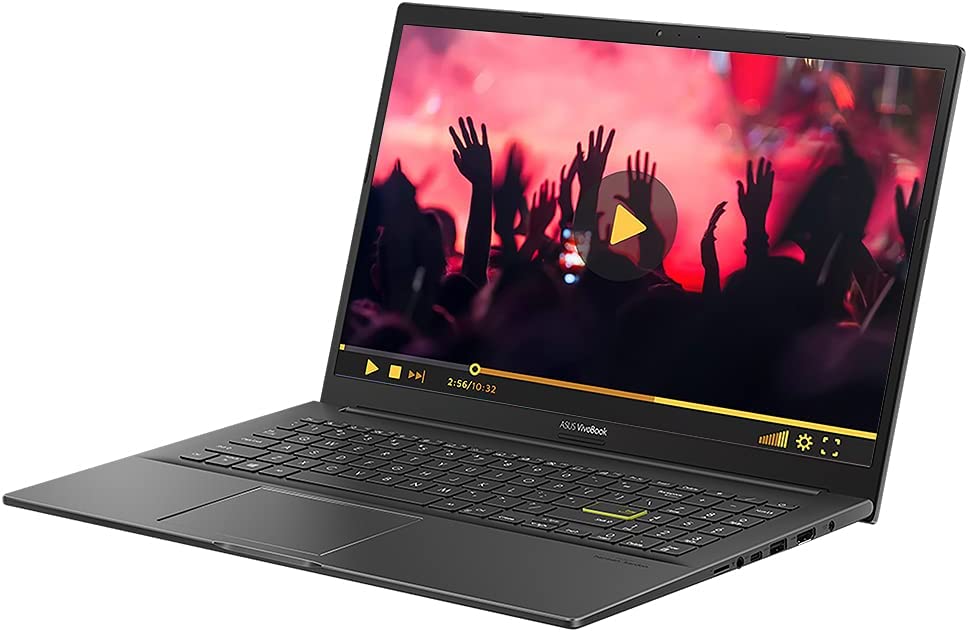Asus Vivobook 15 M513UA-L1282T
Ausstattung / Datenblatt

Preisvergleich
Testberichte für das Asus Vivobook 15 M513UA-L1282T
Quelle: NLT
 EN→DE
EN→DEAnd for my absolutely most favorite part of this laptop – the price. For RM3,499, you get this laptop. I actually think it’s quite an okay price considering that you are getting the powerful AMD Ryzen 7 5700U chip with a beautiful OLED screen. However, the shortcoming – at least for me – is the keyboard. I can live with everything else about this laptop – especially the price. But, maybe you don’t want that much performance on your laptop. Maybe you just want to do some simpler work. Then there’s also another AMD Ryzen 5 5500U version for a lower price of RM3,199 with the same 8GB RAM and 512GB SSD. That is just unbeatable. Just in case you found out about the Intel variant of the Vivobook 15 OLED with the codename K513EA with the enticing price of RM2,799 – I suggest you to proceed with caution. While the Core i3 should be sufficient for most basic tasks, that K513EA version comes with only 4GB RAM. I’m not sure about upgradability but you’ll need to add some ka-ching to make it at least 8GB to be usable. That drives the cost up to about RM3,000 easily.
Einzeltest, online verfügbar, Mittel, Datum: 27.12.2021
Quelle: Tech Critter
 EN→DE
EN→DEWhat we’re going to do today is a gaming test on the ASUS Vivobook 15 M513U. This laptop comes with pretty epic hardware for a low-powered laptop. Equipped with a 15.6-inch 1080p OLED screen, AMD Ryzen 7 5700U, 8GB RAM, and 512GB SSD, this laptop – for the price of RM3,499, this is a pretty decent deal overall. So, let’s dissect this laptop and take a look at what performance it can offer. The current amount of VRAM is 4GB, which is just 50% of the system memory. I’m not sure what will happen to the amount of VRAM if we swap out that 4GB RAM stick for 16GB. Will it become 10GB VRAM? How does it split between the soldered on-board RAM and the 16GB stick? Hmmmm… Anyway, that’s a question for another day. As for now, I’m really loving this laptop’s level of performance. I’m amazed by what the Ryzen 7 5700U has to offer for the price of RM3,499. If you want to learn more about this laptop, check out the review here. Of course, if you don’t need this high level of performance, there is another Ryzen 5 5500U variant with a lower price of RM3,199.
Einzeltest, online verfügbar, Kurz, Datum: 27.12.2021
Quelle: FPT shop
 VN→DE
VN→DEPositive: Good price; decent processor; beautiful design; nice display; rich set of ports; comfortable keyboard.
Einzeltest, online verfügbar, Mittel, Datum: 16.05.2023
Kommentar
Modell:
ASUS Vivobook 15 OLED
Das ASUS Vivobook 15 OLED ist ein Notebook, das sich durch eine Ryzen 7 5700U APU, 16 GB RAM (Dual-Channel-Modus) und einen OLED-Bildschirm (FHD, 15,6 Zoll) auszeichnet. Es verfügt über ein glänzend schwarzes, mattes Gehäuse aus Metall (Rückseite des Deckels) und Kunststoff (Basiseinheit). Der glänzende OLED-Bildschirm (15,6 Zoll, 1.920 x 1.080 Pixel) hat einen ausgezeichneten Kontrast (vor allem Schwarzwerte) und eine kurze Reaktionszeit. Die Helligkeitswerte (370,6 cd/m²) sind gut. Die Reproduktionsrate des sRGB- und DCI-P3-Farbraums liegt bei 100 %, die Reproduktionsrate des Adobe-RGB-Farbraums bei mindestens 98 %. Das blickwinkelstabile Panel lässt sich aus jeder Position ablesen. Das Ablesen im Freien ist aufgrund der spiegelnden Displayoberfläche etwas schwierig.
Die Tasten der unbeleuchteten Holztastatur bieten einen kurzen Unterstrich und einen deutlichen Druckpunkt. Insgesamt bietet Asus eine Tastatur, die für den täglichen Gebrauch gut geeignet ist. Die glatte Oberfläche des Multi-Touch-Trackpads (ca. 10,5 x 7,3 cm) lässt die Finger leicht gleiten und reagiert auch auf Eingaben in Ecken. Das Touchpad hat einen kurzen Hubweg und klare Druckpunkte. Mit dem VivoBook 15 OLED hat Asus ein Office-Notebook im Programm, das sowohl für Office- und Internetanwendungen als auch für einfache Computerspiele genügend Leistung bietet. Die CPU-Sektion der Ryzen 7 5700U APU besteht aus einem Octa-Core-Prozessor, der mit einem Basistakt von 1,8 GHz arbeitet. Mit Turbo kann er bis zu 4,35 GHz erreichen und unterstützt simultanes Multithreading (zwei Threads pro Kern).
Der Ryzen 7 5700U ist gepaart mit AMD Radeon RX Vega 8 (Ryzen 4000/5000), 16GB DDR4 RAM und 512GB SSD Speicher. Das Notebook verfügt über drei herstellerspezifische Leistungsprofile, nämlich "Performance Mode", "Balanced Mode" und "Quiet Mode", zwischen denen der Nutzer mit der Tastenkombination "Fn "+"F" wechseln kann. Was die Konnektivität betrifft, so verfügt der Computer über drei USB-A-Anschlüsse (2 USB 2.0, 1 USB 3.2 Gen 1) und einen USB-C-Anschluss (USB 3.2 Gen 1). Letzterer unterstützt weder Power Delivery noch DisplayPort über USB-C. Das bedeutet, dass nur ein HDMI-Anschluss für die Videoausgabe vorhanden ist. Abschließend lässt sich sagen, dass das Asus Vivobook 15 ein Notebook ist, das über ein schnelles und flüssig laufendes System verfügt, das ausreichend Rechenleistung für Office- und Internetanwendungen bietet. In eingeschränktem Maße sind auch Spiele möglich. Das Display bietet stabile Blickwinkel, eine gute Farbwiedergabe, kurze Reaktionszeiten und eine ausreichend hohe Helligkeit. Damit eignet es sich auch für Berufstätige zum mobilen Arbeiten.
Praktischer Artikel von Jagadisa Rajarathnam
AMD Vega 8: Integrierte Grafikkarte in the Ryzen APUs basierend auf der Vega Architektur mit 8 CUs (= 512 Shader) und einer Taktrate von bis zu 2.000 MHz.
Diese Klasse ist noch durchaus fähig neueste Spiele flüssig darzustellen, nur nicht mehr mit allen Details und in hohen Auflösungen. Besonders anspruchsvolle Spiele laufen nur in minimalen Detailstufen, wodurch die grafische Qualität oft deutlich leidet. Diese Klasse ist nur noch für Gelegenheitsspieler empfehlenswert. Der Stromverbrauch von modernen Grafikkarten in dieser Klasse ist dafür geringer und erlaubt auch bessere Akkulaufzeiten.
» Weitere Informationen gibt es in unserem Notebook-Grafikkartenvergleich und der Benchmarkliste.
R7 5700U: Mobile APU mit acht Zen 2 basierten Kernen welche mit 1,8 bis 4,3 GHz takten. Integriert eine Vega Grafikkarte mit 8 CUs und maximal 1900 MHz. Im Vergleich zum Topmodell, dem R7 5800U, basiert der Prozessor noch auf die Alte Zen 2 und nicht Zen 3 und bietet nur den halben L3-Cache und um 100 MHz geringere Taktraten.» Weitere Infos gibt es in unserem Prozessorvergleich Vergleich mobiler Prozessoren und der Prozessoren Benchmarkliste .
15.60":
15 Zoll Display-Varianten sind der Standard und werden für mehr als die Hälfte aller Notebooks verwendet.
Der Grund der Beliebtheit mittelgrosser Displays ist, dass diese Größe einigermaßen augenschonend ist, hohe Auflösungen oftmals erlaubt und damit Detailreichtum am Bildschirm bietet und dennoch nicht allzu viel Strom verbraucht und die Geräte noch halbwegs kompakt sein können - also schlicht der Standard-Kompromiss.
» Prüfen Sie in unserer DPI Liste, welche Displays wie fein aufgelöst sind.
1.8 kg:
In diesem Gewichtsbereich gibt es besonders leichte Laptops, Convertibles und Subnotebooks, die auf gute Portabilität getrimmt sind.
Asus: ASUSTeK Computer Inc. ist ein großer taiwanesischer Hersteller von Computer-Hardware mit Sitz in Taipeh, gegründet 1989. Unter dem Markennamen Asus fertigt das Unternehmen eine breite Palette von Produkten, darunter Laptops, Desktops, Motherboards, Grafikkarten, Monitore, Smartphones und Netzwerkgeräte, Komplettsysteme und PC-Bauteile für Endkunden.
Unter dem Markennamen ROG (Republic of Gamers) stellt ASUS Gaming-Laptops her, die bei Spielern für ihre leistungsstarken Spezifikationen, dedizierten Grafikkarten, Displays mit hoher Bildwiederholrate und fortschrittlichen Kühlsystemen bekannt sind.
Über das Gaming hinaus werden eine breite Palette von Notebooks für unterschiedliche Anforderungen und Budgets geboten: von ultraschlanken und leichten Ultrabooks bis hin zu vielseitigen 2-in-1-Convertibles und budgetfreundlichen Optionen. 2023 hatte Asus einen Weltmarktanteil von 7% am PC-Markts.
Die Kundenzufriedenheit mit ASUS-Notebooks betrifft Leistung, die Funktionen und das gute Preis-Leistungs-Verhältnis der ASUS-Notebooks. Wie bei jeder Marke gibt es jedoch gelegentlich Berichte über Probleme wie Überhitzung, Treiberkompatibilität oder Probleme mit der Verarbeitungsqualität.
» Lesen Sie auch unsere Notebook-Kaufberatung.


 Deutsch
Deutsch English
English Español
Español Français
Français Italiano
Italiano Nederlands
Nederlands Polski
Polski Português
Português Русский
Русский Türkçe
Türkçe Svenska
Svenska Chinese
Chinese Magyar
Magyar
